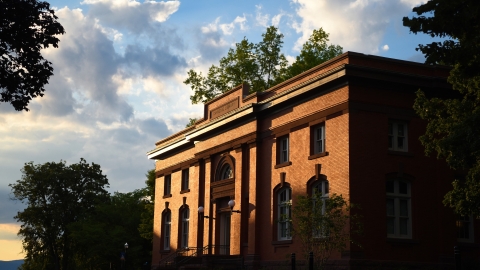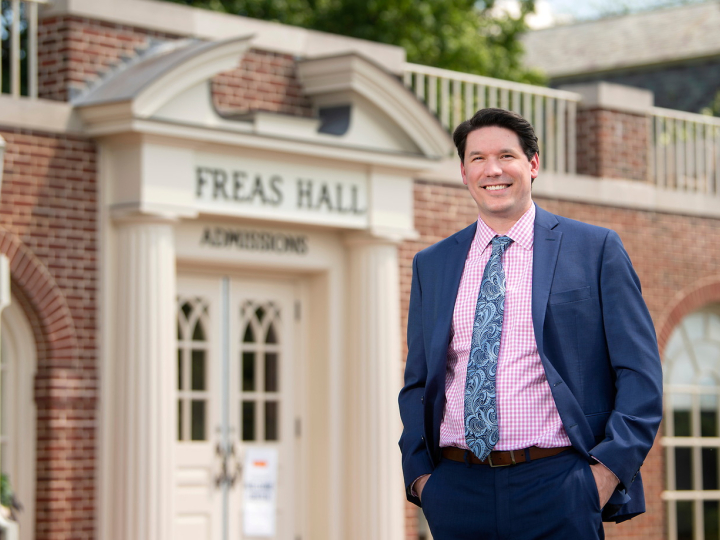
"What a Gem We Gained"
January 27, 2016
Carnegie Building
After a dim six decades, the sun is shining in Bucknell's Carnegie Building once more.
Carnegie, home to what is perhaps Bucknell's most majestic interior, has reopened for the spring semester following a $7-million restoration/renovation that reconstructed its two-story central atrium, which is flanked on two ends by floor-to-ceiling windows and capped by a sky-lit, barrel-arch ceiling.
A gift from steel magnate and philanthropist Andrew Carnegie, the building dates to 1905, when it opened as Bucknell's first dedicated library. Its airy atrium, designed by University President John Harris, served as the building's reading room, a communal space for students to study in the ample natural light — or at least it did during the day; the building was constructed without artificial lighting.
Bucknell has preserved some of Carnegie's original purpose as a student gathering space in reimagining the building for 21st-century students. The building now hosts student and faculty support offices, including Bucknell's Writing Center, Teaching and Learning Center (TLC), Office of Accessibility Resources and the Griot Institute for Africana Studies, all of which share use of the central atrium. They will also share some 15 offices, several private tutoring spaces and a larger conference room, which also borrows light from the skylight through an interior window. The Department of Geology will also maintain its laboratories in the basement, which have also been renovated.
"Carnegie presents a lot of opportunities and a new way of organizing," said Laura Lanwermeyer, the TLC's assistant director for Student Learning Support. "The TLC student programs still have space in Bertrand Library, but the addition of this space in Carnegie provides additional room for our faculty development program, staff meetings and student groups, all of which enables us to better support students.
"The Writing Center staff are some of our best partners on campus," she added. "They support the pedagogy of writing, while we support learning and teaching broadly. We're very excited to have them as neighbors."
In restoring the building, crews from Zartman Construction reversed the work of several previous renovations, which had chopped up the reading room to create additional space for classrooms, offices and equipment. The most severe of those renovations was a 1951 project that decked over the second-floor mezzanine and removed the barrel vault ceiling. The project's architects, Celli-Flynn Brennan Architects & Planners, worked from archival photographs to recreate the second-floor mezzanine balcony and central footbridge using steel capped in pecan-stained, quarter-sawn oak. Other materials and accents, such as built-in bookshelves, floors covered in cork and carpet, and library chairs and tables custom ordered to match the building's original furnishings, offer a nod to the building's past as a library.
The fruit of that effort is an interior considerably more opulent than is found in most buildings on campus. There's a reason for that, noted Dennis Hawley '72, M'73, Bucknell's associate vice president for facilities, who capped off the project before his retirement in December.
Most buildings on Bucknell's campus today were built in the Collegiate Georgian style, a look that was fixed when architect Jens Larsen penned the master plan for the construction of the Academic Quad in 1932. Buildings predating that plan, such as Taylor Hall and the similarly lavish Bucknell Hall, display a mishmash of architectural styles.
"The interior of Carnegie is fancier than most of our buildings; it has more woodwork and architectural appointments inside — the barrel arch ceiling, the skylights, the wood rails and wooden door trims," Hawley said. "That's all very different from what we've typically built. It is a different vernacular, and we have not built anything in this architectural style since."
Crews freshened up the building's exterior as well, cleaning and re-mortaring its brick walls, constructing a new elevator tower, rebuilding exterior staircases and replacing its many windows with double-paned, low emission glass.
I'm happy to see it done for the University," Hawley said of the completed effort. "Not many institutions will move forward with a project that's going to cost $6 or $7 million to restore something. We actually lost space — but what a gem we gained."
The move of student support offices to Carnegie from the first floor of Roberts Hall allowed renovation of that residence hall to begin in December, the day after contractors completed work on Carnegie. Crews from Kinsley Construction will convert the hall's single and double rooms into "semi-suites," in which two to four students will share an in-suite bathroom. The building, the second oldest constructed by the University, will also have its exterior re-clad in new brick. The spaces formerly occupied by the Writing Center and the Griot Institute will become student lounges and gathering spaces, according to Robert Midkiff, Bucknell's associate provost, registrar and dean of graduate studies and summer session.
"The goal was to make Carnegie a building that houses several of the units that support students and faculty and to allow Roberts, when completed, to be a student residence in its entirety," Midkiff said.
Renovations to Roberts Hall will continue into the summer. Construction is also underway at the new Graham Building, which will house Student Health, the Counseling & Student Development Center and wrestling facilities when it opens this spring.

